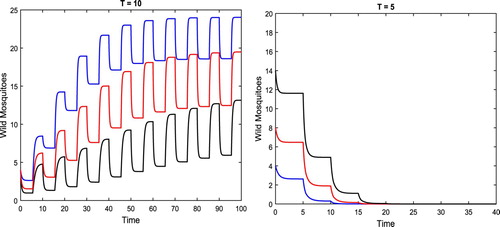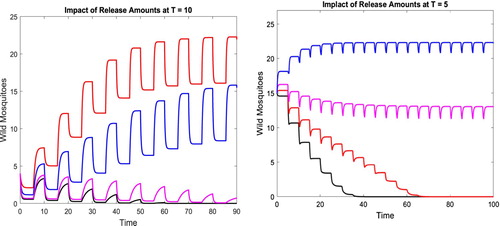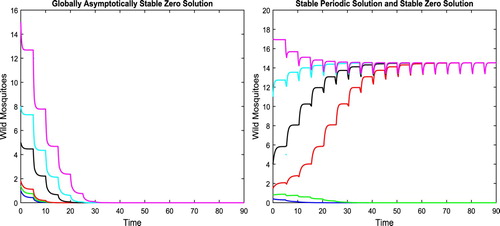Figures & data
Figure 3. The parameters are given in (Equation9(9)
(9) ) such that the release threshold
. We assume that the sterile mosquitoes are released at T = 10 and T = 5, respectively. The solutions for T = 10 are shown in the left figure, where we let c = 10, 15, and 20, and the corresponding solutions are in blue, red, and black, respectively, none of which approaches zero. The solutions for T = 5 are shown in the right figure, where we have c = 10 and
, 8, 14, and the corresponding solutions are in blue, red, and black, respectively, all of which approach zero.

Figure 4. Parameters are given in (Equation9(9)
(9) ) and the release times are T = 10 and T = 5, respectively. The results with different release amounts of sterile mosquitoes c are compared. For T = 10, we gradually increase c from
, to 28. The corresponding solutions w with the same initial values are shown in the left figure. For T = 5, the release amounts c are gradually increased from
, to 7. The corresponding solutions w with the same initial values are shown in the right figure.

Table 1. Summary table for 
 .
.
Figure 5. With parameters given in (Equation13(13)
(13) ),
, and condition (Equation10
(10)
(10) ) holds. There exists a positive 10-periodic solution, between
and
, as shown in the figure.

Table 2. Summary table for 
 and
and 
 .
.
Figure 6. With parameters given in (Equation18(18)
(18) ), condition (Equation14
(14)
(14) ) holds. For
, since
, the zero solution is globally asymptotically stable as shown in the left figure. For
, there exists a periodic solution which seems asymptotically stable as shown in the right figure.



